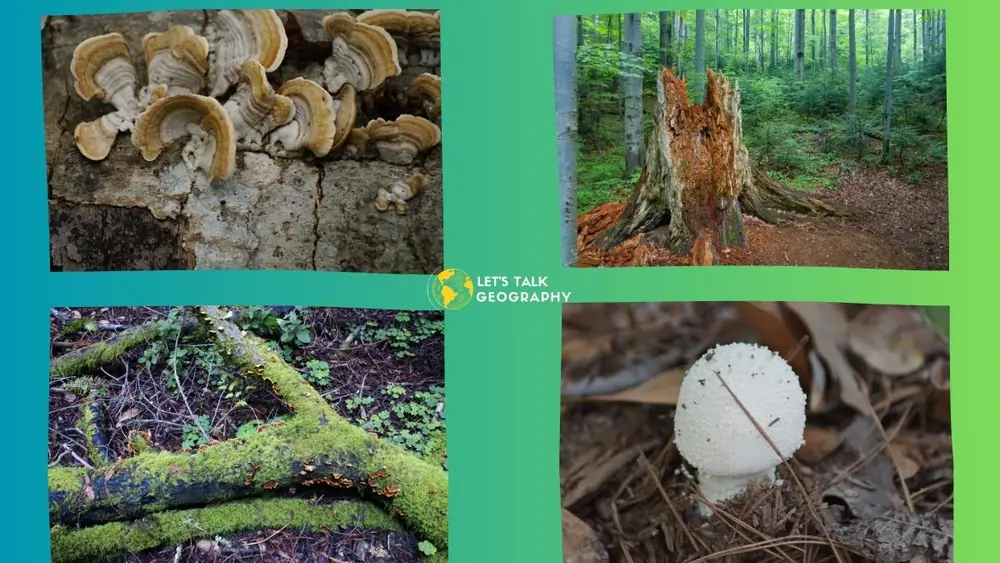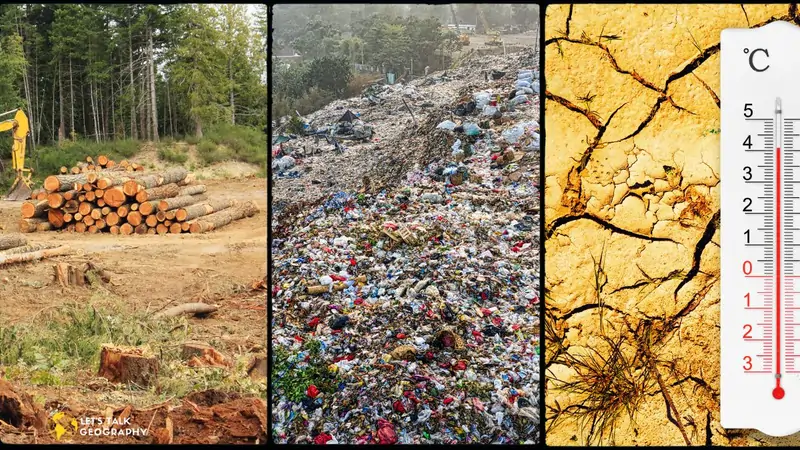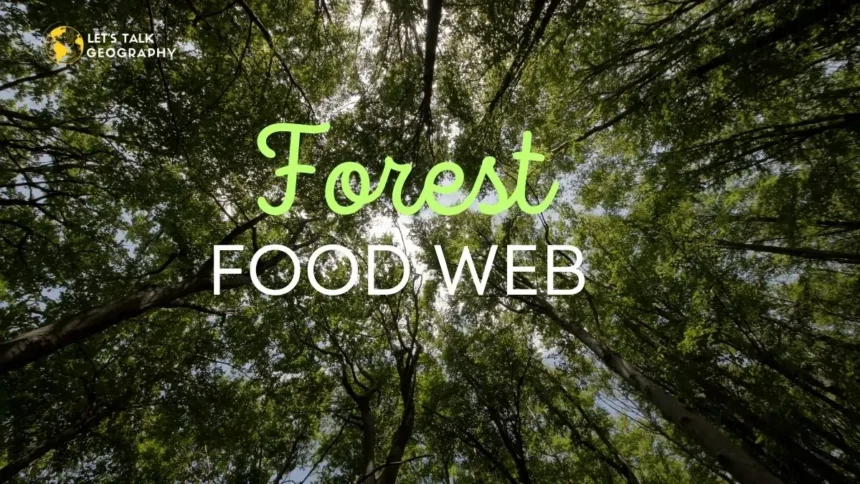Introduction
Imagine walking through a lush, vibrant forest, teeming with life, where every plant and animal plays a crucial role in maintaining the ecosystem’s delicate balance. This intricate forest food web network is essential for sustaining biodiversity and ecosystem health.
The forest food web illustrates how energy and nutrients circulate through the forest, connecting producers, consumers, and decomposers in a complex and interdependent system. Understanding the forest food web is vital, as it highlights the interconnections within nature and the impact of disruptions caused by human activities. By studying these relationships, we gain insights into the resilience of ecosystems and the importance of conservation efforts.
Read also: Ecosystem | Definition, Components, and 5 Important Types of Ecosystem
Read also: Why is Food Web Important? Types of Food web
Components of a Forest Food Web
Producers in the Forest Food Web
All kinds of trees that can run photosynthesis are called the producers of the forest food web. From large trees to small, tiny creepers, all are producers if they have the green pigment called chlorophyll to do photosynthesis. Some algae and a few bacteria also perform photosynthesis; hence, they become the producers of the forest food web.
Consumers in the Forest Food Web
Herbivores
Primary consumers are herbivores that eat plants or algae. Caterpillars, insects, grasshoppers, termites, and hummingbirds are primary consumers because they feed on autotrophs (plants). Large herbivores include elephants, deer, rodents, sloths, and others. Few herbivores, such as the koala, eat only one type of producer.

Carnivores
These are small animals that hunt herbivores. Omnivores, which feed on plants and animals, could be taken as primary and secondary consumers. Small insects, ants, arthropods, frogs, snakes, owls, and other avian species are considered carnivores in forest food webs and food chains.
A few plant species are natural carnivores, including animals. Such as the pitcher plants, sundews, venus flytraps, butterworts, drosera etc. These flesh-eating plants rely on insects, spiders, small frogs, and birds.
Omnivores
These are called apex predators, which are considered hypercarnivorous or omnivorous. These animals are usually at the peak of the food chain and feed on both secondary and primary consumers. These are the big cats like tigers, lions, panthers, jaguars, leopards, cheetahs, etc. Bears, wolves, foxes, and others also fall into this category.
Large snakes, such as pythons and boas, birds, such as hawks and owls, and some deadly fish species, also comprise the highest trophic level of the forest food web.
Read also: Top 12 World’s Most Venomous Snakes: A Deadly Dozen
Decomposers in the Forest Food Web
They are considered nature’s sanitation workers. They break down dead plant and animal remains into nutrient components that can easily be mixed into the soil. This enriches the soil, and plants extract sufficient nutrients from it.
Decomposers in the forest occur in various shapes and sizes. Shelf fungus develops on the sides of trees. It grows into a tree and decomposes at a slow rate. The decomposers have been eating and digesting the material for long, turning it into wonderful dirt for plants.

Decomposers, which mainly include fungi and bacteria, complete the food chain. They turn organic wastes like decaying plants into inorganic materials like nutrient-rich soil. They complete the cycle of life that returns nutrients to the soil and oceans for autotrophs to utilize. Thus, the decomposers are an inevitable part of maintaining the biogeochemical cycles in nature.
Energy Flow in the Forest Food Web
Trophic levels are in the proper series of an ecosystem’s food chain. The initial and lower levels consist of producers. The plants or producers are eaten by second-level organisms called herbivores. At the third level, the primary consumers feed on carnivores. A different trophic level, decomposers or transformers, consists of bacteria and fungi that break down into dead parts and other waste products.
Nature’s balance lies in the balanced functioning of the food web. Any unwanted change in any trophic level will disrupt the whole ecological balance. For instance, unscientific clearing of forest areas will directly affect the number of herbivores. This change, through the ‘predator-prey’ relationship, will eventually affect the number of apex predators. If the balance is not restored, the forest food web will collapse, and the ecosystem will be destroyed.
Read also: Importance of Food Chains In The Energy Flow In The Ecosystem
Energy Transfer Efficiency
The primary energy source in the food chain is the Sun. The sun’s energy is utilized by autotrophic organisms, which consist primarily of green vegetation and are essential for photosynthesis. They use sunlight to change carbon dioxide and water into energy-rich carbohydrates. The heterotrophs are animals and fungi; most are bacteria, while the rest are microorganisms.
Read also: Role of solar energy in sustainable development
In this way, energy in the form of food is transferred from one trophic level to another. However, following Lindemann’s 10% Law, the percentage of energy transfer drops at each level. Hence, the highest trophic level receives the least energy stored in the food made by the producers.
Ecological Pyramids
Ecological pyramids have two to four layers. In these pyramids, organisms depend on similar food sources and are situated on the same level. The producers are located at the lowest levels of an ecological pyramid with a small population. Regarding pyramids of numbers, the peak level will consist of fewer individuals, but their body size and volume increase.
Predator-Prey Dynamics
This is also known as Lotka Volterra dynamics and is made up of a pair of various equations that more easily demonstrate predator-prey dynamics. It was introduced solely by Alfred Lotka and Vito Volterra in 1920. Predators and prey affect each other’s evolution. One trait that can affect predators’ lives is their way of finding and capturing prey that will be selected.
Impact of Human Activities on Forest Food Webs
Deforestation
Deforestation disturbs the ecological balance, negatively impacting the food chain and web. It also ruins wild animals’ natural ecosystems, forcing them to resettle outside their natural habitats or die without a proper place to live.
Read also: Biodiversity Crisis: 5 Shocking Ways We’re Losing Nature’s Riches
Pollution
Pollution affects the food chain and web by affecting organisms’ health, reproduction, and survival at different trophic levels. Pollution in various forms can negatively affect the forest food web. For example, air pollution can lead to acid rain, which can acidify soils and water bodies.
Read also: Environmental Pollution | 7 Types of Pollution and their Alarming Effects

Climate Change
Food webs are very dynamic and well-connected. Therefore, if any changes are made to a particular part of the food web, they will likely be felt across the whole food chain.
Read also: Climate Change | 7 Alarming Effects and the Major Causes Behind
Construction Work
Forest clearing for various construction work destroys the ecosystem. Expansion of transport systems, cities, and industries puts pressure on the remaining forest cover. Due to excessive forest loss, nature can’t regain its homeostatic balance. Rapid industrialization and urbanization shrink the forested land and stress the forest food web.
Conservation of Forest Food Webs
Forests can be conserved by utilizing various steps that include:
- Introduce afforestation programs to restore and conserve forests.
- Charging heavy penalties for illegal forest clearing or felling by authorities
- Preventive measures taken to control forest fires
- Wise and scientific utilization of forest resources
- Poaching and other wildlife-related crimes should be examined very strictly
- The signing of International Agreements on environment & climate by the countries to work together in the conservation and protection of nature and wildlife
- A close examination of the correct running of different International Conservation Programmes, like guidelines of the Earth Summit, Kyoto Protocol, or UN COP Guidelines in every country
Read also: UN COP26 – Is it Too Late to Solve Climate Change Crisis?
Read also: Montreal Protocol: How the World United to Protect the Ozone in 1987
Conclusion
In conclusion, the forest food web is a vital framework that highlights the interconnectedness of all living organisms within a forest ecosystem. By understanding the forest food web, we can appreciate how energy and nutrients flow from producers to consumers and decomposers, maintaining the balance and health of the forest. This intricate web underscores the importance of each species and its role in supporting biodiversity.
Recognizing the impact of human activities on this delicate balance is crucial for implementing effective conservation strategies. As we delve deeper into the dynamics of the forest food web, it becomes evident that preserving these natural networks is essential for sustaining the vitality and resilience of our forests. Let us continue to explore and protect the fascinating intricacies of the forest food web to ensure the longevity of these vital ecosystems for future generations.
FAQs
1. What is a forest food web?
A forest food web is a complex network of interconnected food chains within a forest ecosystem. It illustrates how energy and nutrients flow through the forest, starting from producers (plants) to various consumers (herbivores, carnivores, omnivores) and decomposers (fungi, bacteria). Each organism plays a specific role in ensuring the balance and health of the ecosystem.
2. How do producers contribute to the forest food web?
Producers, mainly plants and trees, are the foundation of the forest food web. They change sunlight into energy through photosynthesis, creating organic matter that serves as food for plant-eating animals. This energy is then passed along the food web as different organisms consume plants and each other. Without producers, the entire food web would collapse, as they are the primary energy source.
3. What role do decomposers play in the forest food web?
Decomposers, like fungi and bacteria, break down dead organic matter, changing essential nutrients in the soil. This process enriches the soil, promoting the growth of plants, which are the leading producers in the forest food web. Decomposers ensure the recycling of nutrients, maintain soil health, and support the entire ecosystem.
4. How does human activity impact the forest food web?
Human activities such as deforestation, pollution, and climate change disrupt the forest food web. Deforestation removes critical habitats, reducing biodiversity and altering the balance of the ecosystem. Pollution contaminates soil and water, affecting the health of all organisms within the web. Climate change alters temperature and weather patterns, impacting species distribution and behavior. These disruptions can lead to the decline or extinction of species and the degradation of the ecosystem.
5. Why is biodiversity important in a forest food web?
Biodiversity ensures the stability and resilience of the forest food web. A diverse range of species contributes to ecosystem functions such as pollination, seed dispersal, and nutrient cycling. High biodiversity increases the ecosystem’s ability to withstand environmental changes and recover from disturbances. It also provides genetic diversities crucial for species adaptation and survival.
6. How can we help protect the forest food web?
Protecting the forest food web involves several actions:
Conservation Efforts: Supporting reforestation and habitat restoration projects.
Sustainable Practices: Reducing deforestation and promoting sustainable land use.
Pollution Reduction: Minimizing pollution through eco-friendly practices and waste management.
Climate Action: Mitigating climate change by reducing carbon emissions and supporting renewable energy.
Education and Advocacy: increasing awareness about the importance of forests and advocating for policies that protect forest ecosystems.
References
- Producers, Consumers, and Decomposers in the forest community. (n.d.). Cnre.vt.edu. Retrieved May 29, 2024, from https://dendro.cnre.vt.edu/forsite/2004presentations/taylor/forsite/forsite.html
- Wikipedia contributors. (2024, April 7). Consumer (food chain). Wikipedia, The Free Encyclopedia. https://en.wikipedia.org/w/index.php?title=Consumer_(food_chain)&oldid=1217798457
- The Editors of Encyclopedia Britannica. (2024). heterotroph. In Encyclopedia Britannica.
- Ecological pyramid – definition, types, importance, limitations. (2022, August 14). GeeksforGeeks. https://www.geeksforgeeks.org/ecological-pyramid-its-types/
- No title. (n.d.). Study.com. Retrieved May 29, 2024, from https://study.com/academy/lesson/symbiotic-relationship-definition-examples-quiz.html
- Predator-prey dynamics. (n.d.). Nimbios.org. Retrieved May 29, 2024, from https://legacy.nimbios.org//~gross/bioed/bealsmodules/predator-prey.html
- Discuss the effects of deforestation on the following. a Wild animals b Environment cVillages Rural areas dCities Urban areas e Earth f The next generation. (2022, July 4). Byjus.com; BYJU’S. https://byjus.com/question-answer/discuss-the-effects-of-deforestation-on-the-following-a-wild-animals-b-environment-c-villages-rural-areas-d-cities-urban-areas-e-earth-f-the-next-generation/
- How to conserve the forest. (2022, July 4). Byjus.com; BYJU’S. https://byjus.com/question-answer/how-to-conserve-forest/





